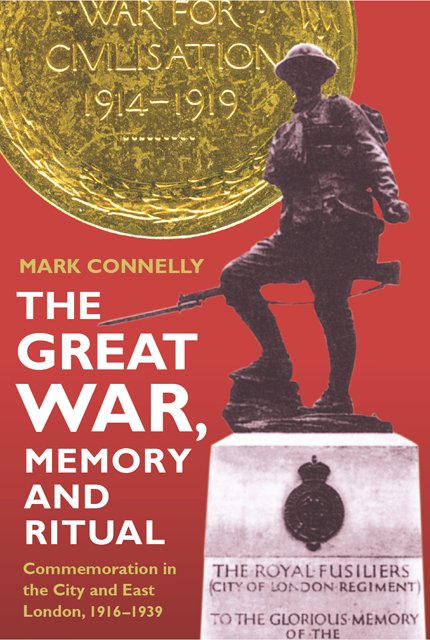Epilogue
Published online by Cambridge University Press: 22 March 2023
Summary
Given the importance of war memorials in the lives of East Londoners after the Great War what then happened after the Second World War? In 1944 a War Memorials Advisory Council was formed under the chairmanship of Lord Chatfield. Mass Observation then organised a survey which indicated that most people objected to stone or sculptural memorials and preferred parks and gardens, ‘which would be useful or give pleasure to those who outlive the war'. How did East London respond to its war dead in 1945? Romford added the dates 1939-1945 to its Great War memorial and erected a recreation hall which included plaques inscribed with the names of both the civilian and military dead. Finally, the borough had its practical memorial. Ilford also added the dates 1939-1945 to its memorial, compiled a book of remembrance, again for civilian and military dead, and unveiled a bronze tablet recording the work of the civil defence services. In accordance with the findings of Mass Observation and after having studied the literature of the War Memorials Advisory Council, East Ham decided to opt for a Garden of Remembrance in Central Park and a Book of Remembrance.
Poplar, Stepney and Bethnal Green, like West Ham, do not appear to have planned much, at least not in the ten years immediately after the war. However, West Ham Council did discuss a grand volume detailing its war record and Bethnal Green and Poplar erected memorials to the council employees who were killed. Finally, in the City, the court of common council voted to add a new inscription to the London Troops’ memorial.
Arnold Whittick, the art historian, writing in 1946, noted the lack of desire for ‘true’ memorials and the enthusiasm for gardens and parks but deplored the attraction of utilitarian memorials. The evidence from East London seems to suggest a slightly more complicated reaction to the Second World War than the simple theory that memorials were rejected and replaced with a desire to erect something useful. Only Romford actually built a truly utilitarian memorial and this was no different from what had been suggested in the town at the end of the Great War. Other districts had indeed built practical memorials after that conflict. East Ham's memorial, though arguably utilitarian, was in fact aesthetic - a flower garden, a thing of beauty.
- Type
- Chapter
- Information
- The Great War, Memory and RitualCommemoration in the City and East London, 1916-1939, pp. 230 - 234Publisher: Boydell & BrewerPrint publication year: 2001

